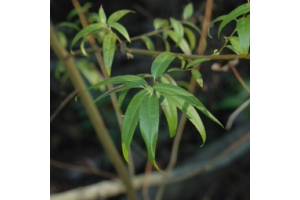Salix is the old Latin name for the willows and caroliniana refers to Carolina. Coastal plain willow is a severe allergen. Salix caroliniana is listed as threatened in Ohio and listed as endangered in Pennsylvania. It is native to the U.S. and is in the Salicaceae (Willow Family).
Photo Credit: © Chris Evans, River to River CWMA, Bugwood.org.
Salix caroliniana
Common Name: coastal plain willow
Plant Functional Group: Deciduous broadleaf
Class > Order > Family: Magnoliopsida > Malpighiales > Salicaceae
What does the species look like?
This perennial, multi-stemmed shrub or small tree (up to 20 feet tall) is dioecious with the male and female trees separate. The branches are reddish to grayish-brown and are thin and brittle. The foliage is green and has a silvery white, waxy coating on the underside of the leaves. The leaves are deciduous. The male flowers are catkins and are pale yellow and inconspicuous. The female flowers have a cluster of small fruits (capsules) with white plume-like hairs that aid in wind dispersal of the seeds.
Salix caroliniana prefers wet soils of stream banks and swamps, at the edge of ponds and marshes. It is considered a high water user and tolerates partial shade to full sun. It is intolerant of long periods of drought.
Coastal plain willow provides food and significant cover for wildlife. In south Florida, it is the only native larval host plant for viceroy (Limenitis archippus ) butterflies; and is also larval host plant for the io moth (Automeris io ).
Where is the species found?
States & Provinces
AL, AR, DC, DE, FL, GA, IL, IN, KS, KY, LA, MD, MO, MS, NC, NJ, OH, OK, PA, SC, TN, TX, VA, WV
Special Considerations for Observing
This species has separate male and female flowers. If you know whether the flowers you are observing are male or female (or both), please make a comment about it for that observation.
Note that individuals of this species with only male flowers will not produce fruit.
Which phenophases should I observe?
Do you see...?
Leaves
Breaking leaf buds More...
How many buds are breaking?
Less than 3 3 to 10 11 to 100 101 to 1,000 1,001 to 10,000 More than 10,000
Leaves More...
What percentage of the potential canopy space is full with leaves? Ignore dead branches in your estimate of potential canopy space.
Less than 5% 5-24% 25-49% 50-74% 75-94% 95% or more
Increasing leaf size More...
What percentage of full size are most leaves?
Less than 25% 25-49% 50-74% 75-94% 95% or more
Colored leaves More...
What percentage of the potential canopy space is full with non-green leaf color? Ignore dead branches in your estimate of potential canopy space.
Less than 5% 5-24% 25-49% 50-74% 75-94% 95% or more
Falling leaves More...
Flowers
Flowers or flower buds Salix caroliniana , both the male and female inflorescence is a catkin which is initially compact, but eventually grows fuller and fluffier. Once the flowers wilt, male catkins dry up, and female catkins turn green and lengthen as the fruits develop.More...
How many flowers and flower buds are present? For species in which individual flowers are clustered in flower heads, spikes or catkins (inflorescences), simply estimate the number of flower heads, spikes or catkins and not the number of individual flowers.
Less than 3 3 to 10 11 to 100 101 to 1,000 1,001 to 10,000 More than 10,000
Open flowers Salix caroliniana , the flowers are open when catkins lengthen and reproductive parts protrude, making the initially compact catkins appear fuller and fluffier.More...
What percentage of all fresh flowers (buds plus unopened plus open) on the plant are open? For species in which individual flowers are clustered in flower heads, spikes or catkins (inflorescences), estimate the percentage of all individual flowers that are open.
Less than 5% 5-24% 25-49% 50-74% 75-94% 95% or more
Pollen release More...
How much pollen is released?
Little: Only a few grains are released. Some: Many grains are released. Lots: A layer of pollen covers your palm, or a cloud of pollen can be seen in the air when the wind blows
Fruits
Fruits Salix caroliniana , the fruit is tiny capsule that changes from green to yellowish and splits open to expose seeds with white fluff. Do not include empty capsules that have already dropped all of their seeds.More...
How many fruits are present?
Less than 3 3 to 10 11 to 100 101 to 1,000 1,001 to 10,000 More than 10,000
Ripe fruits Salix caroliniana , a fruit is considered ripe when it has turned yellowish and has split open to expose seeds with white fluff. Do not include empty capsules that have already dropped all of their seeds.More...
What percentage of all fruits (unripe plus ripe) on the plant are ripe?
Less than 5% 5-24% 25-49% 50-74% 75-94% 95% or more
Recent fruit or seed drop More...
How many mature fruits have dropped seeds or have completely dropped or been removed from the plant since your last visit?
Less than 3 3 to 10 11 to 100 101 to 1,000 1,001 to 10,000 More than 10,000
What do these phenophases look like?
There is currently no photoguide available for this species. If you'd like help us create one, use the guidance document and species template provided here . Then send it via email to education@usanpn.org when it is complete.
